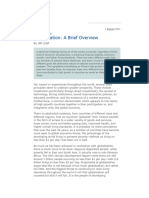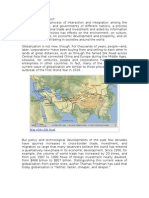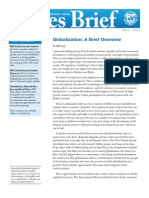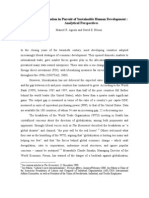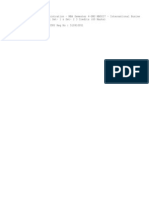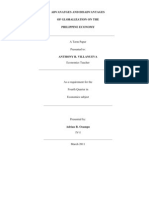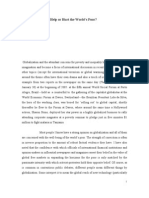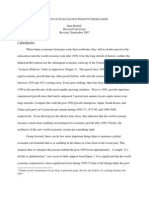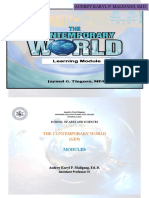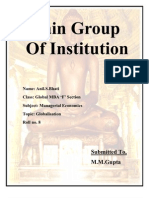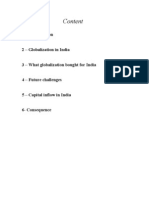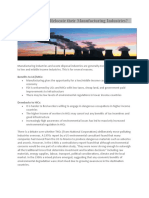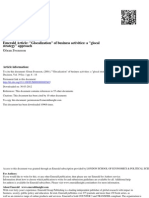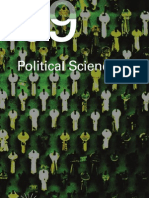Master of Business Administration-MBA Semester 4c
Master of Business Administration-MBA Semester 4c
Uploaded by
Chitra KotihCopyright:
Available Formats
Master of Business Administration-MBA Semester 4c
Master of Business Administration-MBA Semester 4c
Uploaded by
Chitra KotihOriginal Title
Copyright
Available Formats
Share this document
Did you find this document useful?
Is this content inappropriate?
Copyright:
Available Formats
Master of Business Administration-MBA Semester 4c
Master of Business Administration-MBA Semester 4c
Uploaded by
Chitra KotihCopyright:
Available Formats
Master of Business Administration-MBA Semester 4 MB0037 International Business Management - 3 Credits Assignment Set- 1 (60 Marks)
Q.1 What is globalization? What are its benefits? How does globalization help in international business? Give some instances. Ans:What is Globalization? Economic "globalization" is a historical process, the result of human innovation and technological progress. It refers to the increasing integration of economies around the world, particularly through trade and financial flows. The term sometimes also refers to the movement of peopl e ( l abor ) and knowl edg e ( tec hnol og y) ac r oss i nter nati onal bor der s. Ther e ar e al so broader cultural, political and environmental dimensions of globalization that are not covered here. At i ts m ost basi c , ther e i s nothi ng m yster i ous about g l obal i z ati on. The ter m has c om e i nto common usage since the 1980s, reflecting technological advances that have made it easier and quicker to complete international transactions both trade and financial flows. It refers to an extension beyond national borders of the same market forces that have operated for centuries at all levels of human economic activity village markets, urban industries, or financial centers. Markets promote efficiency through competition and the division of labor the specialization that allows people and economies to focus on what they do best. Global markets offer greater opportunity for people to tap into more and larger markets around the world. It means that they can have access to more capital flows, technology, cheaper imports, and larger export market. But markets do not necessarily ensure that the benefits of increased efficiency are shared by all. Countr i es m ust be pr epar ed to em br ac e the pol i c i es needed, and i n the c ase of the poor est countries may need the support of the international community as they do so. Globalization and Growth of Global Economy The term "globalization" has acquired considerable emotive force. Some view it as a process that i s b e n e f i c i a l a key to future world economic development a n d a l s o i n e v i t a b l e a n d irreversible. Others regard it with hostility, even fear, believing that it increases inequality within and between nations, threatens employment and living standards and thwarts social progress. This brief offers an overview of some aspects of globalization and aims to identify ways in which countries can tap the gains of this process, while remaining realistic about its potential and its risks. G l obali z ati on offer s extensi ve oppor tuni ti es for tr ul y wor l dwi de devel opm ent but i t i s not pr ogr essi ng evenl y. Som e c ountr i es ar e bec om i ng i nteg r ated i nto the g l obal e c onom y m or e qui c kl y than other s. Countr i es that have been abl e to i nteg r ate ar e seei ng faster g r owth and reduced poverty. Outward oriented policies brought dynamism and greater prosperity to much of East Asia, transforming it from one of the poorest areas of the world 40 years ago. And as living standardsr ose, i t bec am e possi bl e to m ake pr ogr ess on dem oc r ac y and econom i c i ssues suc h as the environment and work standards. By contrast, in the 1970s and 1980s when many countries in Latin America and Africa pursuedinwardoriented policies, their economies stagnated or declined, poverty increased and high inflation became the norm. In many cases, especially Africa, adverse external developments made the problems worse. As these regions changed their policies, their incomes have begun torise. An important transformation is underway.
Encouraging this trend, not reversing it, is the best course for promoting growth, development and poverty reduction. The crises in the emerging markets in the 1990s have made it quite evident that the opportunities of globalization do not come without risks risks arising from volatile capital movements and the risks of social, economic, and environmental degradation created by poverty. This is not area son to reverse direction, but for all concerned in developing countries, in the advanced countries, and of course investors to embrace policy changes to build strong economies and a stronger world financial system that will produce more rapid growth and ensure that poverty is reduced. H o w c a n t h e d e v e l o p i n g c o u n t r i e s , e s p e c i a l l y t h e p o o r e s t , b e h e l p e d t o c a t c h u p ? D o e s g l obal i z ati on exac er bate i nequal i ty or c an i t hel p to r educ e pover ty? And ar e c ountr i es that integrate with the global economy inevitably vulnerable to instability? These are some of the questions covered in the following sections. G l obal i z ati on i s not just a r ec ent phenom enon. Som e anal ysts have ar g ued that the wor l d economy was just as globalized 100 years ago as it is today. But today commerce and financial services are far more developed and deeply integrated than they were at that time. The most striking aspect of this has been the integration of financial markets made possible by modern electronic communication. Developing countries: How deeply integrated? Globalization means that world trade and financial markets are becoming more integrated. But just how far have developing countries been involved in this integration? Their experience in catching up with the advanced economies has been mixed. Chart 2 shows that in some countries, especially in Asia, per capita incomes have been moving quickly toward levels in the industrial countries since 1970. A larger number of developing countries have made only slow progress or have l ost g r ound. I n par ti c ul ar , per c api ta i nc om es i n Afr i c a have dec l i ned r el ati ve to the industrial countries and in some countries have declined in absolute terms. Chart 2b illustrates part of the explanation: the countries catching up are those where trade has grown strongly. Consider four aspects of globalization: Trade: Developing countries as a whole have increased their share of world trade from19 percent in 1971 to 29 percent in 1999. But Chart 2b shows great variation among the major regions. For instance, the newly industrialized economies (NIEs) of Asia have done well, while Africa as a whole has fared poorly. The composition of what countries export is also important. The strongest rise by far has been in the export of manufactured g oods. The shar e of pr im ar y c om m odi ti es i n wor l d expor ts suc h as food and r aw materials that are often produced by the poorest countries, has declined. Capital movements: Char t 3 depicts what many people associate with globalization, sharply increased private capital flows to developing countries during much of the 1990s.It also shows that:1.the increase followed a particularly "dry" period in the 1980s;2. net offi c i al fl ows of "ai d" or devel opm ent assi stanc e have fal l en sig ni fi c antl y since the early 1980s; and3 . t h e c o m p o s i t i o n o f p r i v a t e f l o w s h a s c h a n g e d d r a m a t i c a l l y . D i r e c t f o r e i g n investment has become the most important category. Both portfolio investment and bank credit rose but they have been more volatile, falling sharply in the wake of the financial crises of the late 1990s Movement of people: Workers move from one country to another partly to find better employment opportunities. The numbers involved are still quite small, but in the period1965-90, the proportion of labor forces round the world that was
foreign born increased by about one-half. Most migration occurs between developing countries. But the flow of migrants to advanced economies is likely to provide a means through which global wages converge. There is also the potential for skills to be transferred back to the developing countries and for wages in those countries to rise. Spread of knowledge (and technology): Information exchange is an integral, often overlooked, aspect of globalization. For instance, direct foreign investment brings not onl y an expansi on of the physi c al c api tal stoc k, but al so tec hni c al i nnovati on. Mor e generally, knowledge about production methods, management techniques, export markets and economic policies is available at very low cost, and it represents a highly valuable resource for the developing countries. The special case of the economies in transition from planned to market economies they too are becoming more integrated with the global economy is not explored in much depth here. In fact, the term "transition economy" is losing its usefulness. Some countries (e.g. Poland, Hungary) are converging quite rapidly toward the structure and performance of advanced economies. Others (such as most countries of the former Soviet Union) face long term structural and institutional issues similar to those faced by developing countries.
Q.2 What is culture and in the context of international business environment how does it impact international business decisions? Ans;Culture and International Business The following can be looked as the various aspects of the cultural dichotomies. Cultural Dichotomies I n thi s new m i ll enni um , few exec uti ves c an afford to tur n a bl i nd eye to g l obal busi ness opportunities. Japanese auto-executives monitor carefully what their European and Korean c om peti tor s ar e up to i n g etti ng a bi gg er sl ic e of the Chi nese auto-m ar ket. E xec uti ves of Hollywood movie studios need to weigh the appeal of an expensive movie in Europe and Asia as much as in the US before a firm commitment. The globalizing wind has broadened the mindsets of executives, extended the geographical reach of firms, and nudged international business (IB)research into some new trajectories. One such new trajectory is the concern with national culture. W h e r e a s t r a d i t i o n a l I B r e s e a r c h h a s b e e n c o n c e r n e d w i t h e c o n o m i c / l e g a l i s s u e s a n d organizational forms and structures, the importance of national culture broadly defined as values, beliefs, norms, and behavioral patterns of a national group has become increasingly important in the last two decades, largely as a result of the classic work of Hofstede (1980). National culture has been shown to impact on major business
activities, from capital structure(Chui et al., 2002) to group performance (Gibson, 1999). For reviews, see Boyacigiller andAdler (1991) and Earley and Gibson (2002).The purpose of this Unit is to provide a state-of-the-art review of several recent advances in culture and IB research, with an eye toward productive avenues for future research. It is not our p u r p o s e t o b e c o m p r e h e n s i v e ; o u r g o a l i s t o s p o t l i g h t a f e w h i g h l y p r o m i s i n g a r e a s f o r leap fogging the field in an increasingly boundary-less business world. We first review the issues surrounding cultural convergence and divergence, and the processes underlying cultural changes. We then examine novel constructs for characterizing cultures, and how to enhance the precision of cultural models by pinpointing when the effects of culture are important. Finally, we examine the usefulness of experimental methods, which are rarely employed in the field of culture and IB.A sc hem ati c sum m ar y of our c over ag e i s g i ven i n Tabl e 2. 1, whi c h sug g ests that the topi c s reviewed are loosely related, and that their juxtaposition in the present paper represents our attempt to highlight their importance rather than their coherence as elements of an integrative framework. Cultural change, convergence and divergence in an era of partial globalization An i ssue of c onsi der abl e theor etic al si g ni fi c anc e i s c onc er ned wi th c ul tur al c hang es and transformations taking place in different parts of the world. In fact, since the landmark study of Haire et al. (1966) and the publication of Industrialism and Industrial Man by Kerr et al. (1960),researchers have continued to search for similarities in culture-specific beliefs and attitudes in various aspects of work related attitudes and behaviors, consumption patterns, and the like. If cultures of the various locales of the world are indeed converging (e.g., Heuer et al., 1999), IB-related practices would indeed become increasingly similar. Standard, culture-free business practices would eventually emerge, and inefficiencies and complexities associated with divergent beliefs and practices in the past era would disappear. In the following section, we review the evidence on the issue and conclude that such an outlook pertaining to the convergence of various IB practices is overly optimistic.
Q.3 Explain the meaning of the term trade liberalization and advantages. Also, identify some commonly observed mistakes in international trade. Ans- P ol ic i es that m ake an ec onom y open to tr ade and i nvestm ent wi th the r est of the wor l d ar e needed for sustai ned ec onom ic g r owth. The evi denc e on thi s i s c l ear. No c ountr y i n r ec ent decades has achieved economic success, in terms of substantial increases in living standards for its people, without being open to the rest of the world. In contrast, trade opening (along with opening to foreign direct investment) has been an important element in the economic success of East Asia, where the average import tariff has fallen from 30 percent to 10 percent over the past20 years. Openi ng up thei r ec onom i es to the g l obal ec onom y has been essenti al i n enabl ing m any developing countries to develop competitive advantages in the manufacture of certain products. In these countries, defined by the World Bank as the "new globalizes," the number of people in absolute poverty declined by over 120 million (14 percent) between 1993 and 1998 There is considerable evidence that more outward-oriented countries tend consistently to grow faster than ones that ar e i nwar d-l ooki ng. I ndeed, one fi ndi ng i s that the benefi ts of tr ade liberalization can exceed the costs by more than a factor of 10. Countries that have opened their ec onomi es i n r ec ent year s, i nc l udi ng I ndi a, Vi etnam , and Ug anda, have exper i enc ed faster growth and more poverty reduction. On average, those developing countries that lowered tariffs sharply in the 1980s grew more quickly in the 1990s than those that did not. Freeing trade frequently benefits the poor especially. Developing countries can ill-afford the large implicit subsidies, often channeled to narrow privileged interests that trade protection provides. Moreover, the increased growth that results from free trade itself tends to increase the incomes of the poor in roughly the same proportion as those of the population as a whole. New jobs are created for unskilled workers, raising them into the middle class. Overall,
inequality among countries has been on the decline since 1990, reflecting more rapid economic growth in developing countries, in part the result of trade liberalization. The potential gains from eliminating remaining trade barriers are considerable. Estimate of the gains from eliminating all barriers to merchandise trade range from US$250 billion to US$680 billion per year. About two-thirds of these gains would accrue to industrial countries. But the amount accruing to developing countries would still be more than twice the level of aid they c u r r e n t l y r e c e i v e . M o r e o v e r , d e v e l o p i n g c o u n t r i e s w o u l d g a i n m o r e f r o m g l o b a l t r a d e liberalization as a percentage of their GDP than industrial countries, because their economies are more highly protected and because they face higher barriers. Although there are benefits from improved access to other countries markets, countries benefit most from liberalizing their own markets. The main benefits for industrial countries would come from the liberalization of their agricultural markets. Developing countries would gain about equal l y fr om li ber al iz ati on of m anufac tur i ng and ag r i c ul tur e. The gr oup of l ow-i nc om e countries, however, would gain most from agricultural liberalization in industrial countries because of the greater relative importance of agriculture in their economies. Advantages of International Trade Enhance your domestic competitiveness Increase sales and profits Gain your global market share Reduce dependence on existing markets Exploit international trade technology Reduce dependence on existing markets Exploit international trade technology Extend sales potential of existing products Stabilize seasonal market fluctuations Enhance potential for expansion of your business Sell excess production capacity Maintain cost competitiveness in your domestic market
Q.4 Explain the product life cycle theory. Ans:Product Life Cycle Theory Life cycle theory has been used since the 1970s to describe the behavior of a product or service from design to obsolescence. The typi c al patter n of a pr oduc t i s r epr esented by a c ur ve di vi ded i nto four di sti nc t phases: introduction, growth, maturity, and decline. Recent research in the area has focused on its use indecision making in areas ranging from those as broad as overall strategy to those as narrow as equipment replacement. But does the product life cycle, or PLC, really tell the entire story? Consider the Ford Mustang. Since its 1964 introduction, the automobile has undergone several changes. Performance was increased with the addition of the 428 CobraJet in 1968 and Mach I styling in 1969. Another substantial change took place in 1971 with the introduction of the high-performance Boss 351.Then a true muscle car, the Mustang was detuned in 1974, when oil prices forced a more fuelefficient redesign, called Mustang II. The fourth generation Mustang, introduced as the 1994model, has been further refined and is more aerodynamic than its immediate predecessor. Yet its till shares roots with earlier models. A 302 V-8 is still offered, the wheelbase is similar, and if one looks closely enough, one can see its genesis in the 1964 model. The pattern evidenced by the life of the Mustang, then, is several curves of introduction, growth, maturity, and decline. Another intriguing example is the C-130 Hercules aircraft manufactured by Lockheed. The company recently announced the sale of 25 "J" models to the Royal Air Force, which is the fifth version of the Hercules originally produced in the 1950s. Although the aircraft resembles its older relatives, the new model features a totally different electronics package and more powerful engines. Here again, the Hercules PLC shows a curve with five local maximum points (swells of activity, in effect), rather than the traditional, single maximum point, PLC curve. The exam pl es above sug g est a P L C m odel
r epr esented by waves of pr oduc t i ntr oduc ti ons, growth, maturity, and decline. Design engineering, process engineering, product marketing, production, and end-of-life decisions are key elements within the system. Each has its own cycle consisting of varying levels of activity. The waves are triggered by critical decision points during
Q.5 Discuss the implications of Heckscher-Ohlin theory model. Ans:Heckscher-Ohlin Trade Model The Heckscher-Ohlin (HO hereafter) model was first conceived by two Swedish economists, EliHeckscher (1919) and Bertil Ohlin. Rudimentary concepts were further developed and added later by Paul Samuelson and Ronald Jones among others. There are four major components of the HO model 1. Fac tor - P r i ce E qual i z ati on Theor em ,2 . S t o l p e r - S a m u e l s o n T h e o r e m , 3 . R y b c z y n s k i T h e o r e m , a n d 4. Hec ksc her -Ohl i n Tr ade Theor em. Due to the difficulty of predicting the goods trade pattern in a world of many goods, instead of the Heckscher-Ohlin Theorem, the HeckscherOhlin-Vanek Theorem that predicts the factor content of trade received attention in recent years. Eli Heckscher (1879 1952) Heckscher was a Swedish economist. He is probably best known for his book "Mercantilist."Although his major interest was in studying economic history, he also developed the essentials of the factor endowment theory of international trade in a short article in Swedish in 1919. It was translated into English thirty years later. Bertil Ohlin (1899-1979) Heckscher s student, Bertil Ohlin developed and elaborated the factor endowment theory. He was not only a professor of economics at Stockholm, but also a major political figure in Sweden. He served in Riksdag (Swedish Parliament), was the head of liberal party for almost a 1/4 of a century. He was Minister of Trade during World War II. In 1979 Ohlin was awarded a Nobel prize jointly with James Meade for his work in international trade theory. HO Model = 2 2 2 model (2 countries, 2 commodities, 2 factors)For example, there are two countries (America and Britain); each country is endowed with 2homogeneous factors (labour and capital) and produces 2 commodities. This is the smallest case of " even " model, i.e., the number of commodities is equal to that of factors. Extending the model to a more general case is not easy. In fact, the results obtained from a more general model do not have the clear, common sense interpretations which the simple HOmodel enjoys. Q.6 Do you think WTO is helpful for promoting international business? Give reasons for your answer. Ans:The past 50 years have seen an exceptional growth in world trade. Merchandise exports grew on average by 6% annually. Total trade in 2000 was 22-times the level of 1950. GATT and t h e W T O h a v e h e l p e d t o c r e a t e a s t r o n g a n d p r o s p e r o u s t r a d i n g s y s t e m c o n t r i b u t i n g t o unprecedented growth. The system was developed through a series of trade negotiations, or rounds, held under GATT. The first rounds dealt mainly with tariff reductions but later negotiations included other are a such as anti-dumping and non-tariff measures. The last round the 1986-94 Uruguay Round led to the creation of WTO. The result
is assurance. Consumers and producers know that they can enjoy secure supplies and greater choice of the finished products, components, raw materials and services that they use. Producers and exporters know that foreign markets will remain open to them. The result is also a more prosperous, peaceful and accountable economic world. Virtually all decisions in the WTO are taken by consensus among all member countries and they are ratified by members' parliaments. Trade friction is channeled into the WTO's dispute settlement process wher e the foc us i s on i nter pr eting ag r eem ents and c omm i tm ents, and how to ensur e that countries' trade policies conform with them. That way, the risk of disputes spilling over into political or military conflict is reduced. By lowering trade barriers, the WTO s system also breaks down other barriers between peoples and nations. At the heart of the system known as the m ul ti l ater al tr ading system ar e the WTO s agreements, negotiated and signed by a large majority of the world s trading nations, and ratified in their parliaments. These agreements are the legal ground-rules for international commerce. Essentially, they are contracts, guaranteeing member countries important trade rights. They also bind governments to keep their trade policies within agreed limits to everybody s benefit. The agr eem ents wer e neg oti ated and sig ned by g over nm ents. But thei r pur pose i s to hel p producers of goods and services, exporters, and importers conduct their business. The goal is to improve the welfare of the peoples of the member countries.
Master of Business Administration -MBA Semester 4MB0037 International Business ManagementAssignment Set- 2 Q.1 What is WTO? What is GATT? Explain both. Ans:What is the WTO? The Wor l d Tr ade Org ani z ati on was establ i shed in 1995. I t i nc l udes 153 c ountr i es and i s headquartered in Geneva, Switzerland. The WTO has been used to push an expansive array of policies on trade, investment and deregulation that exacerbate the inequality between the North and the South, and among the rich and poor within countries. The WTO enforces some twenty different trade agreements, including the General Agreement on Trade in Services (GATS), the Agreement on Agriculture (AoA) and TradeRelated Intellectual Property Rights (TRIPS).The WTO is inherently undemocratic. Its trade tribunals, working behind closed doors, have r u l e d a g a i n s t a s t u n n i n g a r r a y o f n a t i o n a l h e a l t h a n d s a f e t y , l a b o r , h u m a n r i g h t s a n d environmental laws, which have been directly challenged as trade barriers by governments acting on behalf of their corporate clients. National policies and laws found to violate WTO rules must be eliminated or changed or else the violating country faces perpetual trade sanctions that can be in the millions of dollars. Since the WTO's inception in 1995, the vast majority of rulings in trade disputes between member nations have favored powerful industrialized countries. Consequently, many countries, particularly developing countries, feel enormous pressure to weaken their public interest policies whenever a WTO challenge is threatened in order to avoid costly sanctions The WTO s Predecessor, The GATT, Was Established on a Provisional Basis after the Second World War in the wake of other new multilateral institutions dedicated to international economic cooperation notably the "Britton Woods" institutions now known as the World Bank and the International Monetary Fund. The ori g i nal 23 G ATT c ountr i es wer e am ong ove r 50 whi c h ag r eed a dr aft Char ter for an International Trade Organization (ITO) a new specialized agency of the United Nations. The Charter was intended to provide not only world trade disciplines but also contained rules relating to employment, commodity agreements, restrictive business practices, international investment and services. In an effort to give an early boost to trade liberalization after the Second World War and to begin to correct the large overhang of protectionist measures which remained in place from the early1930s-tariff negotiations were opened among the 23 founding GATT "contracting parties" in1946. This first round of negotiations resulted in 45,000 tariff concessions affecting $10 billion or about one-fifth of world trade. It was also agreed that the value of these concessions should be protected by early and largely "provisional" acceptance of some of the trade rules in the draft ITO Charter. The tariff concessions and rules together became known as the General Agreement on Tariffs and Trade and entered into force in January 1948.Although the ITO Charter was finally agreed at a UN Conference on Trade and Employment in Havana in March 1948, ratification in national legislatures proved impossible in some cases .When the United States government announced, in 1950, that it would not seek Congressional ratification of the Havana Charter, the ITO was effectively dead. Despite its provisional nature, the GATT remained the only multilateral instrument governing international trade from 1948until the establishment of the WTO. Although, in its 47 years, the basic legal text of the GATT remained much as it was in 1948,ther e wer e addi ti ons i n the form of "pl ur al -l ater al vol untar y m em ber shi p ag r eem ents and continual efforts to reduce tariffs. Much of this was achieved through a series of "trade rounds".
Q.2 What is MNC? Explain the 3 stages of evolution. Ans:- MNCs or m ul ti nati onal c or por ati ons ar e busi nesse s that oper ate i n m or e than one country. Usually these companies have a center of operations or some head office in one country, wi th suboffi c es and/or other fac i l i ties l oc ated i n other countr i es. These fac i l i ties m ay be connected to the head office or parent company through a merger or as some form of subsidiary company. Multinational Corporations are large companies that can do business locally and internationally. Most multinational corporations operating today come from the US, Japan, and Western Europe. Popular brands we know today are products of multinational corporations. These brands include Coca-Cola the best known softdrink brand in many countries, Nike known worldwide for quality shoes and apparel, Honda car and motorcycle maker from Japan, and many others. Multinational corporations penetrate new markets or countries through business mergers or ac qui si ti ons, sequenti al m ar ket entr y, and/or joi nt ventur es wi th other sm all er busi nesses. Coming in as a foreign investment, MNCs capitalize on their size and resources to take over companies in a new country. With tightening competition, many MNCs are in the lookout for companies to acquire or merge with, not only to boost sales but also to gain market share from other industry players. Sequential Market Entry is also one option for MNCs to gain presence in a new market. In this way, one MNC may opt to start small and invest in one product at a time. Little by little, the product line will be increased to boost presence in the area. MNCs also do joint ventures with existing players in a particular country. In this way, the venture partner may retain some autonomy from the parent MNC while enjoying the benefits of technology and/or expertise transfer. Many agree that the entry of multinational corporations can greatly help the economy of a particular country. But skeptics also believe that MNCs are selfish and are only concerned of their business bottom line. They are seen as too large and too powerful as many of them have some sort of influence over governments, which will lead to exploitation especially t o developing economies. Three Stages of Evolution 1. Export stage initial inquiries firms rely on export agents expansion of export sales further expansion foreign sales branch or assembly operations (to save transport cost) 2. Foreign Production Stage There is a limit to foreign sales (tariffs, NTBs) DFI versus Licensing Once the firm chooses foreign production as a method of delivering goods to foreign markets, itmust decide whether to establish a foreign production subsidiary or license the technology to aforeign firm. Licensing Licensing is usually first experience (because it is easy)
e.g.: Kentucky Fried Chicken in the U.K. it does not require any capital expenditure it is not risky payment = a fixed % of sales Problem: the m other fi rm c annot exer c i se any m anag er i al c ontr ol over the l ic ensee ( i t i s independent)The licensee may transfer industrial secrets to another independent firm, thereby creating a rival. Direct Investment It requires the decision of top management because it is a critical step. it is risky (lack of information) (US firms tend to establish subsidiaries in Canada first. Singer Manufacturing Company established its foreign plants in Scotland and Australia in the 1850s) plants are established in several countries licensing is switched from independent producers to its subsidiaries. export continues 3. Multinational Stage The company becomes a multinational enterprise when it begins to plan, organize and coordinate production, marketing, R&D, financing, and staffing. For each of these operations, the firm mustfind the best location. Q.3 Mention the differences between currency markets and exchange rate markets in thecontext of international business environment Ans:Exchange Rate Markets and Currency Markets The exchange rate regimes adopted by countries in today s international monetary and financia lsystem, and the system itself, are profoundly different from those envisaged at the 1944 meetingat Bretton Woods establishing the IMF and the World Bank. In the Bretton Woods system: exchange rates were fixed but adjustable. This system aimed both to avoid the undue volatility thought to characterize floating exchange rates and to prevent competitive depreciations, while permitting enough flexibility to adjust to fundamental disequilibrium under international supervision;
private capital flows were expected to play only a limited role in financing payments imbalances, and widespread use of controls would prevent instability in such flows; temporary official financing of payments imbalances, mainly through the IMF, would smooth the adjustment process and avoid unduly sharp correction of current account imbalances, with their repercussions on trade flows, output, and employment. In the current system, exchange rates among the major currencies (principally the U.S. dollar, the euro, and Japanese yen) fluctuate in response to market forces, with short-run volatility and occasional large medium-run swings (Figure 1). Some medium-sized industrial countries also have m ar ket deter m i ned fl oati ng r ate r eg i m es, whi le other s have adopted har der peg s ,including some European countries outside the euro area. Developing and transition economies have a wide variety of exchange rate arrangements, with a tendency for many but by no means all countries to move toward increased exchange rate flexibility (Figure 2).T h i s v a r i e t y o f e x c h a n g e r a t e r e g i m e s e x i s t s i n a n e n v i r o n m e n t w i t h t h e f o l l o w i n g characteristics: partly for efficiency reasons, and also because of the limited effectiveness of capital c ontr ol s, i ndustr i al c ountr i es have g ener all y abandoned suc h c ontr ol s and em er gi ng market economies have gradually moved away from them. The growth of international c api tal fl ows and g l obali z ati on of fi nanc i al m ar kets has al so been spurr ed by the revolution in telecommunications and information technology, which has dramatically lowered transaction costs in financial markets and further promoted the liberalization and deregulation of international financial transactions; international private capital flows finance substantial current account imbalances, but the c h a n g e s i n t h e s e flows appear also sometimes to be a cause of macroeconomic disturbances or an i m p o r t a n t c h a n n e l t h r o u g h w h i c h t h e y a r e t r a n s m i t t e d t o t h e international system;
developing and transition countries have been increasingly drawn into the integrating wor l d ec onom y, i n term s of both their tr ade i n g oods and ser vi c es and of fi nanc i al transactions. Lessons from the recent crises in emerging markets are that for such countries with important linkages to global capital markets, the requirements for sustaining pegged exchange rate regimes have become more demanding as a result of the increased mobility of capital. Therefore, regimes that allow substantial exchange rate flexibility are probably desirable unless the exchange rate is firmly fixed through a currency board, unification with another currency, or the adoption of another currency as the domestic currency (dollarization).Flexible exchange rates among the major industrial country currencies seem likely to remain a key feature of the system. The launch of the euro in January 1999 marked a new phase in the evolution of the system, but the European Central Bank has a clear mandate to focus monetary pol i c y on the dom esti c objec ti ve of pr i c e stabi l i ty r ather than on the exc hang e r ate. Many medium-sized industrial countries, and developing and transition economies, in an environment of i nc r e asi ng c api tal m ar ket i ntegr ati on, m ay al so c onti nue to m ai ntai n m ar ket-deter m i ned floating rates, although more countries could may adopt harder pegs over the longer term. Thus, prospects are that: exchange rates among the euro, the yen, and the dollar are likely to continue to exhibit volatility, and schemes to reduce volatility are neither likely to be adopted, nor to be desirable as they prevent monetary policy from being devoted consistently to domestic stabilization objectives; sever al of the tr ansi ti on c ountr i es of c entr al and easter n E ur ope, espec i all y those preparing for membership in the European Union, are likely to seek to establish over time the policy disciplines and institutional structures required to make possible the eventual ad option of the euro. The approach taken by the IMF continues to be to advise member countries on the implications of adopting different exchange rate regimes, to consider the choice of regime to be a matter for each country to decide and to provide policy advice that is consistent with the maintenance of the chosen regime. Q.4 a) Explain the role of privatization in international business. b) Mention the relevance of these international commercial terms: FCA, EXW,DES, CIF and DDP Ans:A Role of privatization in international business As noted above, economists generally agreed on the need for speed in carrying out liberalization and stabilization. But on privatization of large enterprises, there was a debate on whether to have a rapid transfer of assets from the state to the private sector or to adopt a more gradual approach .Advoc ates of r api d pr i vati z ati on c al l ed for el im i nati ng state owner shi p by gi vi ng assets to citizens, for instance, through vouchers that gave their holders the right and means to purchase state-owned companies on sale. They were motivated by considerations of fairness, a desire to give ordinary citizens a stake in the economy. They also perceived a need to seize the window of oppor tuni ty that had opened for pr i vati z ati on befor e the state bur eauc r ac i es r egr ouped and resisted the process. Others advocated a more gradual scaling back of state enterprises as new private sector firms emerged in the economy. They were in favor of the privatization of enterprises through the sale of assets to those likely to work on improving the performance of the companies. They also stressed the imposition of hard budget constraints on enterprises so that chronic loss makers woul d be for c ed out, l eaving the m or e pr ofi tabl e enter pr i ses to attr ac t i nvestor s. Hung ar y followed this gradualist approach to privatization, and it appears to have proved more conducive to genuine restructuring of enterprises .By contrast, experience has shown some of the pitfalls of the rapid privatization approach. In the Czech Republic, for instance, the assets transferred to millions of ordinary citizens in the first phase of r api d pr ivati zati on wer e sol d by the r ec i pi ents and ended up bei ng c onsol i dated i n investment funds. But there was no genuine restructuring of enterprises, either because the investment funds lacked the capital to develop them or because the funds were in turn controlled by state-owned banks that did not impose hard budget constraints. The weak growth performance of the Czech Republic in the late-1990s, relative to other CEE countries, is attributed in part to its weak enterprise reforms. Rapid privatization fared even worse in Russia. The country s mass privatization programme of 1992-94 transferred ownership of over 15,000 firms into private hands. However, contrary to expectations, insider privatization did not lead to self-induced restructuring of firms. It was hoped that secondary trading would introduce outside ownership, and that transparent methods would be
used in the second wave of privatization of remaining firms still in state hands. Neither hope was fulfilled. Insiders were wary of relinquishing control; workers feared the cost-cutting that might occur under outside control, and managers found it easier to keep enterprises alive by lobbying the state for subsidies than to foster competitive performance through involvement of outsi der s. The second wave of pri vati z ati on, i n par ti c ul ar the so-c al l ed "l oans-for -shar es" scheme, was non-transparent and systematically excluded foreign investors and banks in favors of parties with ties to government interests. Over al l , the experi enc e of the tr ansi ti on ec onom i es sug g ests that pr i vati z ed fi rm s tend to r e s t r u c t u r e m o r e q u i c k l y a n d p e r f o r m b e t t e r t h a n c o m p a r a b l e f i r m s t h a t r e m a i n i n s t a t e ownership, but only if complementary conditions are met. These conditions include the presence of hard budget constraints and competition, effective standards of corporate governance, and an effective legal structure and property rights. In contrast to the mixed experience on privatization of large enterprises, the privatization of small scale enterprises has been generally successful and has been completed in all but five countries. Q.5 Give short notes on Letter of credit and Bill of Lading Ans:- Letter of Credit A letter of credit is a document issued mostly by a financial institution which usually provides an irrevocable payment undertaking (it can also be revocable, confirmed, unconfirmed, transferable or other s e. g. bac k to bac k: r evol vi ng but i s m ost c om m onl y i rr evoc able/c onfi r m ed) to a beneficiary against complying documents as stated in the credit. Letter of Credit is abbreviated as an LC or L/C, and often is referred to as a documentary credit, abbreviated as DC or D/C, documentary letter of credit, or simply as credit (as in the UCP 500 and UCP 600). Once the beneficiary or a presenting bank acting on its behalf, makes a presentation to the issuing bank or confirming bank, if any, within the expiry date of the LC, comprising documents complying with the term s and c ondi ti ons of the L C, the appl i c abl e UCP and i nter nati onal standar d banki ng practice, the issuing bank or confirming bank, if any, is obliged to honor irrespective of any instructions from the applicant to the contrary. In other words, the obligation to honor (usually payment) is shifted from the applicant to the issuing bank or confirming bank, if any. Non-banks can also issue letters of credit however parties must balance potential risks. Letters of credit accomplish their purpose by substituting the credit of the bank for that of the customer, for the purpose of facilitating trade. There are basically two types: commercial and standby. The commercial letter of credit is the primary payment mechanism for a transaction ,whereas the standby letter of credit is a secondary payment mechanism. Elements of a Letter of Credit A payment undertaking given by a bank (issuing bank) On behalf of a buyer (applicant) To pay a seller (beneficiary) for a given amount of money On presentation of specified documents representing the supply of goods Within specified time limits Documents must conform to terms and conditions set out in the letter of credit Documents to be presented at a specified place Bill of Lading A Bill of Lading is a type of document that is used to acknowledge the receipt of a shipment of goods and is an essential document in transporting goods overland to the exporter s international carrier. A through Bill of Lading involves the use of at least two different modes of transport fr om r oad, r ail , ai r and sea. The ter m der i ves fr om the noun "bil l ", a sc hedul e of c osts for services supplied or to be supplied, and from the verb "to lade" which means to load a cargo onto ship or other form of transport. In addition to acknowledging the receipt of goods, a Bill of Lading indicates the particular vessel on which the goods have been placed, their intended destination, and the terms for transporting the shipment to its final destination. Inland, ocean, through, and airway bill are the names given to bills of lading.
Q.6 Discuss the entry methods in international business with relevant examples. Ans;Tr ade i s i nc r easi ng l y g l obal i n sc ope today. There ar e sever al r easons for thi s. One significant reason is technological because of improved transportation and communication opportunities today, trade is now more practical. Thus, consumers and businesses now have access to the very best products from many different countries. Increasingly rapid technology lifecycles also increases the competition among countries as to who can produce the newest in technology. In part to accommodate these realities, countries in the last several decades have taken increasing steps to promote global trade through agreements such as the General Treaty on Trade and Tariffs, and trade organizations such as the World Trade Organization (WTO), North American Free Trade Agreement (NAFTA), and the European Union (EU). Stages in the International Involvement of a Firm We discussed several stages through which a firm may go as it becomes increasingly involved ac r oss bor der s. A pur el y dom esti c fi rm foc uses onl y on i ts hom e m ar ket, has no c ur r ent ambitions of expanding abroad, and does not perceive any significant competitive threat from abroad. Such a firm may eventually get some orders from abroad, which are seen either as an irritation (for small orders, there may be a great deal of effort and cost involved in obtaining relatively modest revenue) or as "icing on the cake." As the firm begins to export more, it enters the export stage, where little effort is made to market the product abroad, although an increasing number of foreign orders are filled. In the international stage, as certain country markets begin to appear especially attractive with more foreign orders originating there, the firm may go into c ountr i es on an ad hoc basi s that i s, eac h c ountr y m ay be enter ed sequenti al l y, but wi th relatively little learning and marketing efforts being shared across countries. In the multi-national stage, some efficiency is pursued by standardizing across a region (e.g., Central America, West Africa, or Northern Europe). Finally, in the global stage, the focus centers on the entire World market, with decisions made optimize the product s position across markets the home country is no longer the centre of the product. An example of a truly global company is Coca Cola. Note that these stages represent points on a continuum from a purely domestic orientation to a truly global one; companies may fall in between these discrete stages, and different parts of the firm may have characteristics of various stages for example, the pickup truck division of an auto-manufacturer may be largely domestically focused, while the passenger car division is globally focused. Although a global focus is generally appropriate for most large firms, note that it may not be ideal for all companies to pursue the global stage. For example, manufacturers of ice cubes may do well as domestic, or even locally centered, firms. Methods of entry With rare exceptions, products just don t emerge in foreign markets overnight a firm has to build up a market over time. Several strategies, which differ in aggressiveness, risk, and the amount of control that the firm is able to maintain, are available: Exporting is a relatively low risk strategy in which few investments are made in the new country. A drawback is that, because the firm makes few if any marketing investments in the new country, market share may be below potential. Further, the firm, by not operating in the country, learns less about the market (What do consumers really want? Which kinds of advertising campaigns are most successful? What are the most effective methods of distribution?) If an importer is willing to do a good job of marketing, this arrangement may represent a "win-win" situation, but it may be more difficult for the firm to enter on its own later if it decides that larger profits can be made within the country. Licensing and franchising are also low exposure methods of entry you allow some one else to use your trademarks and accumulated expertise. Your partner puts up the money and assumes the risk. Problems here involve the fact that you are training a potential c om peti tor and that you have l i ttl e c ontr ol over how the busi ness i s oper ated. For example, American fast food restaurants have found that foreign franchisees often fail to maintain American standards of cleanliness. Similarly, a foreign manufacturer may use lower quality ingredients in manufacturing a brand based on premium contents in the home country.
Contract manufacturing involves having someone else manufacture products while you take on some of the marketing efforts yourself. This saves investment, but again you may be training a competitor. Direct entry strategies, where the firm either acquires a firm or builds operations "from scratch" involve the highest exposure, but also the greatest opportunities for profits. The firm gains more knowledge about the local market and maintains greater control, but now has a huge investment. In some countries, the government may expropriate assets without compensation, so direct investment entails an additional risk. A variation involves a joint venture, where a local firm puts up some of the money and knowledge about the local market.
Master of Business Administration-MBA Semester 4 MB0037 International Business Management - 3 Credits Assignment Set- 2 (60 Marks) Note: Each question carries 10 Marks. Answer all the questions. Q.1 What is WTO? What is GATT? Explain both. [10 marks] Q.2 What is MNC? Explain the 3 stages of evolution. [10 marks] Q.3 Mention the differences between currency markets and exchange rate markets in the context of international business environment. [10 marks] Q.4 a) Explain the role of privatization in international business. [05 marks] b) Mention the relevance of these international commercial terms: FCA, EXW, DES, CIF and DDP [05 marks] Q.5 Give short notes on Letter of credit and Bill of Lading [10 marks] Q.6 Discuss the entry methods in international business with relevant examples. [10 marks]
You might also like
- Beyer and Beaman - Religion, Globalization and Culture (2007) PDFDocument617 pagesBeyer and Beaman - Religion, Globalization and Culture (2007) PDFJerrick Raper100% (1)
- Rostow's Theory: Examples of The Different Stages of The Rostow ModelDocument19 pagesRostow's Theory: Examples of The Different Stages of The Rostow ModelShahriar HasanNo ratings yet
- Answer: The Term "Globalization" Has Acquired Considerable Emotive Force. Some View It As Process That IsDocument2 pagesAnswer: The Term "Globalization" Has Acquired Considerable Emotive Force. Some View It As Process That IsMD RezaNo ratings yet
- Q.1 What Is Globalization? What Are Its Benefits? How Does Globalization Help in International Business? Give Some Instances. AnswerDocument5 pagesQ.1 What Is Globalization? What Are Its Benefits? How Does Globalization Help in International Business? Give Some Instances. AnswerNicholas Campos100% (1)
- GlobalizationDocument3 pagesGlobalizationsameer shaikhNo ratings yet
- Globalization Term PaperDocument31 pagesGlobalization Term PaperSP_singh90% (20)
- Globalization: Historical DevelopmentDocument9 pagesGlobalization: Historical DevelopmentManisha TomarNo ratings yet
- MB0037 International Business ManagementDocument23 pagesMB0037 International Business ManagementsasyamNo ratings yet
- Q1W4 Lesson 1 Concrete Effects of Globalization and To Ones Daily LifeDocument7 pagesQ1W4 Lesson 1 Concrete Effects of Globalization and To Ones Daily LifeLeslie TabuzoNo ratings yet
- Issues Brief - Globalization - A Brief OverviewDocument12 pagesIssues Brief - Globalization - A Brief OverviewVon Rother Celoso DiazNo ratings yet
- Globalization and CSRDocument25 pagesGlobalization and CSRAmbreen ZainebNo ratings yet
- MB0037Document8 pagesMB0037Venu GopalNo ratings yet
- INTL 101 - GlobalizationDocument27 pagesINTL 101 - Globalizationirs_ijs190% (1)
- What Is GlobalizationDocument5 pagesWhat Is GlobalizationJitendra KumarNo ratings yet
- Responding To Globalization: India's AnswerDocument14 pagesResponding To Globalization: India's Answerneelesh_361497No ratings yet
- Globalization - A Brief OverviewDocument8 pagesGlobalization - A Brief OverviewfbonciuNo ratings yet
- 1 IMF Globalization OverviewDocument19 pages1 IMF Globalization OverviewGuillemNo ratings yet
- What Is GlobalizationDocument22 pagesWhat Is GlobalizationPrashant SharmaNo ratings yet
- Master of Business Administration - MBA Semester 4 MB0037 - International Business Management Assignment Set-1Document36 pagesMaster of Business Administration - MBA Semester 4 MB0037 - International Business Management Assignment Set-1Araj99No ratings yet
- MB0037 - International Business Management Assignment Set-1Document39 pagesMB0037 - International Business Management Assignment Set-1Tushar PatilNo ratings yet
- Chapter 6 - Global DevelopmentDocument12 pagesChapter 6 - Global DevelopmentVictoria Margarett N. FangNo ratings yet
- Global Integration in Pursuit of Sustainable Human Development: Analytical PerspectivesDocument25 pagesGlobal Integration in Pursuit of Sustainable Human Development: Analytical PerspectivesCarmel PuertollanoNo ratings yet
- Chapter 01: Globalization: Critical Thinking and Discussion QuestionsDocument3 pagesChapter 01: Globalization: Critical Thinking and Discussion QuestionsSulaima Asif100% (1)
- Globalization:-: According To TheDocument6 pagesGlobalization:-: According To ThekirthubaNo ratings yet
- MB0037 - International Business Management Assignment Set-1Document38 pagesMB0037 - International Business Management Assignment Set-1morepradeepNo ratings yet
- MB0037 FALL 2010 SolutionsDocument41 pagesMB0037 FALL 2010 Solutionshumayun25666No ratings yet
- GFL 587 Trade Vs AidDocument4 pagesGFL 587 Trade Vs AidavaniNo ratings yet
- Globalization and Its Impacts On PAK ECODocument23 pagesGlobalization and Its Impacts On PAK ECOwaqasidrees393No ratings yet
- Economic Globalization Trends, Risks and Risk PreventionDocument10 pagesEconomic Globalization Trends, Risks and Risk Preventionakshaykr1189No ratings yet
- Development Chapter FiveDocument54 pagesDevelopment Chapter FiveGammachu GoshuNo ratings yet
- Q1. Write A Note On Globalization.: 1. Trade: Developing Countries As A Whole Have Increased Their Share of World TradeDocument6 pagesQ1. Write A Note On Globalization.: 1. Trade: Developing Countries As A Whole Have Increased Their Share of World TradeYogesh MishraNo ratings yet
- Advanatges and Disadvantages of Globalization in The Phil. Economy-Economics ThesisDocument8 pagesAdvanatges and Disadvantages of Globalization in The Phil. Economy-Economics ThesisAdrian R. Ocampo33% (3)
- 1_6773ff639fb003beeedc0056f92dadf0Document11 pages1_6773ff639fb003beeedc0056f92dadf0Hania RusinowskaNo ratings yet
- SST ProjectDocument37 pagesSST ProjectShriti Sikta PandaNo ratings yet
- Different Definitions of GlobalizationDocument6 pagesDifferent Definitions of GlobalizationNajira HassanNo ratings yet
- SHIXUE (2003) - Third World Approach To Globalization - Comparing Latin America and ChinaDocument9 pagesSHIXUE (2003) - Third World Approach To Globalization - Comparing Latin America and ChinamarceloscarvalhoNo ratings yet
- Does Globalization Help or Hurt The World's Poor?Document16 pagesDoes Globalization Help or Hurt The World's Poor?nifa_lko8420No ratings yet
- Ow To AVE Lobalization ROM TS HeerleadersDocument33 pagesOw To AVE Lobalization ROM TS HeerleadersKarin PotterNo ratings yet
- Poverty GlobalizationDocument14 pagesPoverty Globalizationsiscani3330No ratings yet
- The Contemporary World Module 2Document27 pagesThe Contemporary World Module 2Dan Christian VillacoNo ratings yet
- Globalization 2Document5 pagesGlobalization 2lightningmcking2No ratings yet
- Conl Shoaib AssignmentDocument63 pagesConl Shoaib AssignmentMuneeb AbbasiNo ratings yet
- Lorenzo - SOCSCI 1 - ASSIGNMENT 1Document4 pagesLorenzo - SOCSCI 1 - ASSIGNMENT 1Mia Fe Cuaya LorenzoNo ratings yet
- ANil Table of ContentsDocument10 pagesANil Table of ContentsAnil BhatiNo ratings yet
- New Microsoft Word DocumentDocument22 pagesNew Microsoft Word DocumentAjay PandayNo ratings yet
- International Business Environment and Foreign Exchange EconomicsDocument3 pagesInternational Business Environment and Foreign Exchange EconomicsVivek SinghNo ratings yet
- Reaction or Reflection Paper No. 9Document5 pagesReaction or Reflection Paper No. 9Armie RicoNo ratings yet
- TCW Act #4 EdoraDocument5 pagesTCW Act #4 EdoraMon RamNo ratings yet
- Assignment: MBA - SEM IV Subject Code: MB0037 International Business Management Set IDocument18 pagesAssignment: MBA - SEM IV Subject Code: MB0037 International Business Management Set Ichitradeepd09No ratings yet
- Contempo PrelimDocument8 pagesContempo Prelimmayaridump75No ratings yet
- EM Final ProjectDocument46 pagesEM Final Projectpervineelashry100% (1)
- Reaping The Benefits of GlobalizationDocument8 pagesReaping The Benefits of GlobalizationFelis_Demulcta_MitisNo ratings yet
- Chapter 1 QuizDocument9 pagesChapter 1 QuizRyan SalipsipNo ratings yet
- Meeting Globalization's Challenges: Policies to Make Trade Work for AllFrom EverandMeeting Globalization's Challenges: Policies to Make Trade Work for AllNo ratings yet
- The Next Convergence: The Future of Economic Growth in a Multispeed WorldFrom EverandThe Next Convergence: The Future of Economic Growth in a Multispeed WorldRating: 4 out of 5 stars4/5 (2)
- The Global Economy Explained - A Layman's Guide to Understanding World MarketsFrom EverandThe Global Economy Explained - A Layman's Guide to Understanding World MarketsNo ratings yet
- Apel, Karl-Otto - Globalization and The Need For Universal Ethics PDFDocument19 pagesApel, Karl-Otto - Globalization and The Need For Universal Ethics PDFGonzalo ScivolettoNo ratings yet
- Decolonizing The University New Directions - Achille Joseph Mbembe PDFDocument17 pagesDecolonizing The University New Directions - Achille Joseph Mbembe PDFMiguel ErrazuNo ratings yet
- Resilient Eu 2030Document81 pagesResilient Eu 2030juliasotoalvarezNo ratings yet
- Full Download Economics Making Sense of the Modern Economy 2nd Edition Simon Cox PDF DOCXDocument60 pagesFull Download Economics Making Sense of the Modern Economy 2nd Edition Simon Cox PDF DOCXcodeelenny6h100% (10)
- Why Do Tncs Move Their Manufacturing IndustriesDocument2 pagesWhy Do Tncs Move Their Manufacturing IndustriesZoe IraniNo ratings yet
- Mycbseguide: Class 12 - Business Studies Term 1 - Business Environment - 01Document5 pagesMycbseguide: Class 12 - Business Studies Term 1 - Business Environment - 01Aria GraceNo ratings yet
- General Education Curriculum Holistic Understanding, Intellectuals and Civic CompetenciesDocument29 pagesGeneral Education Curriculum Holistic Understanding, Intellectuals and Civic CompetenciesMerline Gomez100% (2)
- "Glocalization" ofDocument14 pages"Glocalization" ofmaarghe87No ratings yet
- PPC CompiledDocument16 pagesPPC Compiledallysa riveraNo ratings yet
- Economic Challenges and Opportunities For North Eastern Region of IndiaDocument22 pagesEconomic Challenges and Opportunities For North Eastern Region of IndiaRishabh Sen GuptaNo ratings yet
- Bacc 121 Module OneDocument9 pagesBacc 121 Module OnehwoNo ratings yet
- TCW Outline Syllabus 2023 2024Document7 pagesTCW Outline Syllabus 2023 2024Llana Loren TiroNo ratings yet
- Why Study International Business ??Document38 pagesWhy Study International Business ??Dullur ManasaNo ratings yet
- Hu & Mckay 2012 English Language Ed in E.Asia PDFDocument20 pagesHu & Mckay 2012 English Language Ed in E.Asia PDFRolf NaidooNo ratings yet
- The Globalization Phenomenon-MergedDocument81 pagesThe Globalization Phenomenon-MergedGerrie Mae GrimaldoNo ratings yet
- Operations and Supply Chain ManagementDocument44 pagesOperations and Supply Chain ManagementLoay MohammedNo ratings yet
- Baum TM2015 Human Resources in TourismDocument21 pagesBaum TM2015 Human Resources in TourismKiran ANo ratings yet
- Citigroup Study On Global ProtestsDocument48 pagesCitigroup Study On Global ProtestsJustin WedesNo ratings yet
- Marketing Strategies of NokiaDocument92 pagesMarketing Strategies of NokiaJennz Monty100% (1)
- Compilation of Notes and Activities For: Week 5 (Topic 5)Document8 pagesCompilation of Notes and Activities For: Week 5 (Topic 5)mascardo franz100% (1)
- Natura Complexa Si Dinamica A Mediului de SecuritateDocument388 pagesNatura Complexa Si Dinamica A Mediului de SecuritateLiviu TimothyNo ratings yet
- Lesson 2 Globalisation and The Mass Media BlogDocument11 pagesLesson 2 Globalisation and The Mass Media BlogPatrick Franz SabacajanNo ratings yet
- The Finance Professional 2020-ACCADocument20 pagesThe Finance Professional 2020-ACCAAyodeji Yosef OlumoNo ratings yet
- Operations Management CIA-1Document3 pagesOperations Management CIA-1Evis RejiNo ratings yet
- UBC Press Political Science Catalogue 2009-2010Document60 pagesUBC Press Political Science Catalogue 2009-2010UBC Press University of British Columbia Press100% (2)
- Unit 3 GlobalisationDocument16 pagesUnit 3 GlobalisationAdjepoleNo ratings yet
- Globalisation, Culture and Psychology-2Document7 pagesGlobalisation, Culture and Psychology-2Emma BaderNo ratings yet
- Internatinal BuisnessDocument7 pagesInternatinal BuisnessSankalp AwasthiNo ratings yet
- JWL 005 04 Sapiro Transnational Literary FieldDocument25 pagesJWL 005 04 Sapiro Transnational Literary FieldozturkmerveNo ratings yet









